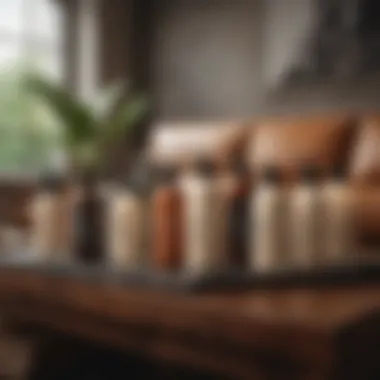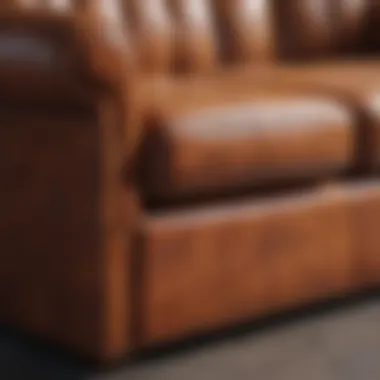Natural Leather Conditioner for Sofas: A Detailed Guide


Intro
When it comes to maintaining the beauty and longevity of leather furniture, homeowners often find themselves at a crossroads. The allure of rich, natural leather can easily become marred by neglect, heat, and pollutants. Enter natural leather conditioners—these products might just be your best-kept secret for souffle-soft sofas that will withstand the test of time.
But why should one pay extra attention to their leather furniture? Well, leather is a living material that deserves more than the occasional dusting. Much like how we nurture our gardens or clean our homes, leather requires a periodic pampering regimen. Natural leather conditioners not only nourish but also shield this investment against stains, dryness, and fading.
In this guide, we’ll delve deep into the world of natural leather care. We'll highlight why it's crucial to choose the right conditioner, unravel effective application techniques, and discuss the long-term benefits of these eco-friendly options. From exploring trending styles and color palettes to understanding the nuances of seasonal maintenance, we will cover it all. Ready to embark on this journey? Let’s get started!
Understanding Leather and Its Needs
When we bring a leather sofa into our homes, we’re welcoming not just furniture, but a slice of nature crafted into its plush form. Understanding what leather is and how to care for it is an essential cornerstone of maintaining its allure. Many people may see leather as just another upholstery option, but it involves a deeper understanding of its origins, the processes it undergoes, and the care it demands.
Nature of Leather
Leather is derived from animal hide, most commonly from cattle. However, several other animals like goats and sheep also contribute their skins. The charm of leather lies in its organic texture and aesthetic appeal. Because leather is a natural material, it breathes and ages in a unique manner. This aging process gives it character but also brings vulnerabilities such as dryness and cracking over time.
Understanding the composition of leather is crucial. Most leather types fall into three categories: full grain, top grain, and genuine leather.
- Full grain: This retains the natural texture and imperfections of the hide, providing a rich and durable surface.
- Top grain: This type is sanded for a smoother feel, but it loses some of its natural characteristics.
- Genuine leather: While affordable, it's generally less durable and may not carry the same depth of character as the others.
Each type deserves individual care considerations, which leads us directly to the necessity of conditioning.
Why Conditioning Is Necessary
Conditioning leather is akin to moisturizing skin. Without proper nourishment, leather can dry out, lose its elasticity, and develop cracks. Conditioning is vital for several reasons:
- Preservation: Regular application of conditioner not only prolongs the lifespan of leather but also helps maintain its aesthetic charm.
- Protection: Conditioner acts as a barrier against environmental factors, shielding leather from dust, dirt, and stains that can mar its surface.
- Hydration: Just like plants need water, leather needs oils to keep it supple. Over time, leather can lose its natural oils, leading to dryness.
"A well-conditioned leather sofa isn’t just an investment; it’s a promise of enduring beauty and comfort."
Despite its robust nature, leather can be susceptible to damage from everyday use. Coffee spills, kids’ sticky fingers, or even sunlight can take their toll. Therefore, making conditioning part of your routine care is not just advisable—it’s essential all things considered.
Types of Leather Conditioners
Understanding the different types of leather conditioners is pivotal for anyone looking to maintain their leather sofa. The right conditioner not only enhances the look of your leather but also plays a crucial role in its longevity. When choosing a product, knowing the nuances between various types can make a significant difference. Here, we dive into the various categories, examining their benefits and what to consider before making a choice.
Natural vs. Synthetic Conditioners
When it comes to leather conditioners, the two primary categories that often pop up are natural and synthetic. Both have their own virtues, but they cater to different needs and preferences.
Natural Conditioners are typically formulated from oils and waxes sourced from plants or animal products. They are lauded for their ability to nourish the leather while preserving its natural qualities. For instance, beeswax or coconut oil can deeply penetrate the leather fibers, adding moisture and maintaining suppleness. These products generally emit fewer chemicals, making them a healthier choice for households.
On the flip side, Synthetic Conditioners often contain a mix of chemical ingredients designed to imitate the properties of natural oils. They may provide some advantages in terms of ease of application and cost-effectiveness. However, a lot of synthetic options may include solvents and other additives that might not be skin-friendly or environmentally sound.
"Choosing between natural and synthetic leather conditioners is more than a simple comparison; it reflects your values regarding sustainability, health, and the care of your leather investments."
Ultimately, your choice will depend on your priorities: If you're environmentally conscious and prefer products with fewer chemicals, natural conditioners would likely be your go-to. However, if you seek convenience and cost-efficiency, synthetic options might catch your eye.
Creams, Sprays, and Oils
The texture and application method of leather conditioners matter just as much as the ingredients. Understanding whether to reach for a cream, spray, or oil can impact not just the effectiveness but also the ease of your maintenance routine for your leather sofa.


- Cream Conditioners are thick and usually provide a rich consistency which allows for targeted application. They work well for deeper conditioning and can fill tiny cracks. With creams, it's often a one-and-done deal; just apply and let the conditioner do its magic.
- Spray Conditioners offer convenience and are great for quick touch-ups. The key advantage here is uniform application over large areas. However, it's essential to ensure that a spray conditioner offers adequate penetration into the leather.
- Oils, while less common in commercial form, are a classic choice. They help to feed and hydrate the leather, restoring its natural sheen and flexibility. Just be cautious, as oils can sometimes lead to a sticky surface if over-applied.
In summary, selecting the right type of conditioner is an important step in ensuring that your leather sofa remains stunning and functional for years. The choice between natural and synthetic often reflects personal values, while the decision among creams, sprays, or oils can dictate your maintenance habits.
Choosing the Right Leather Conditioner
Choosing the right leather conditioner is a pivotal step in the long-term care and maintenance of your leather sofa. A good conditioner not only enhances the appearance of your furniture but also plays an essential role in preserving its quality over time. There are various factors to consider when selecting a conditioner, including leather type, desired outcomes, and personal health and environmental preferences. The stakes are high—selecting an ill-suited product can lead to irreversible damage. Understanding these elements can significantly impact your satisfaction with your leather sofa.
Assessing Leather Quality
Before diving into conditioner selection, one must assess the quality of the leather in your sofa. Leather comes in several grades, from top-grain to bonded leather, each with its unique characteristics and requirements. Here’s how to recognize your leather type:
- Full-Grain Leather: The most durable form, often with natural markings. Requires conditioning that maintains its texture.
- Top-Grain Leather: Slightly processed compared to full-grain, it's less prone to staining but still benefits from regular conditioning.
- Split Leather: Generally more affordable, yet less durable. Needs a specialized conditioner to prevent drying out.
- Bonded Leather: Made from leather scraps, it's not as durable and often requires more frequent conditioning.
To assess your leather:
- Touch: High-quality leather feels pliable and soft. Poor-quality leather may feel fibrous or have plastic-like features.
- Look: Check for natural imperfections. Genuine leather has beauty marks; synthetic options may appear too uniform.
Understanding what you’re working with will help you pick a conditioner tailored to your sofa's needs, ensuring that you're not just applying a one-size-fits-all solution.
Eco-Friendly Considerations
In today's world, many consumers are also focusing on the environmental impact of the products they use. Choosing an eco-friendly conditioner is becoming a significant concern. Many conventional conditioners may contain synthetic chemicals, solvents, and petroleum-based ingredients, which can be harmful both to your health and the environment. Here are a few considerations when searching for greener options:
- Look for Natural Ingredients: Choose products made with plant-based oils like coconut or jojoba. They condition without introducing harmful substances.
- Check Certifications: Brands that carry eco-certifications often adhere to higher environmental standards. Certifications by organizations like Ecocert or USDA Organic can be a good indicator.
- Consider Packaging: Eco-friendly products often feature recyclable packaging. Supporting brands that prioritize sustainability in their packaging can make a positive difference.
When you keep your sofa sleek and fashionable while caring for the environment, it becomes a win-win situation. Not only do you have beautiful furniture, but you also make a conscientious choice that reflects your values.
"The leather on your sofa awaits your prudent choice of conditioner. Discover its qualities, and you'll find the right match that brings out the best for years to come."
In summary, selecting the right leather conditioner is no trivial matter. It requires a careful examination of your leather's qualities and a thoughtful consideration of eco-friendly options available. By doing so, homeowners can achieve a delicate balance between maintaining the beauty of their leather furniture and aligning with healthier lifestyle choices.
Application Techniques for Conditioners
When it comes to maintaining the beauty and longevity of a leather sofa, applying a natural leather conditioner isn't just a choice—it's a necessity. Proper application techniques can significantly influence how well the conditioner penetrates the leather, ensuring the material remains supple and visually appealing. Understanding the nuts and bolts of this process not only boosts the effectiveness of the conditioner but also helps in preventing any unintended damage.
Preparing the Sofa
Before diving into applying the conditioner, it's crucial to prep your sofa like you would before painting a masterpiece. This initial step sets the stage for successful application and can make a world of difference.
- Clean the Surface: Start with a gentle clean. Use a microfiber cloth—this soft fabric won't scratch the leather. You can dampen the cloth slightly with water or a designated leather cleaner to get rid of any dust, dirt, or spills. Make sure it's not soaking wet—just enough to moisten it.
- Inspect the Leather: Check for any scratches or cracks. If you spot them, it may be worth addressing those before applying the conditioner. A good rule of thumb is to use leather filler or a similar product to treat those areas.
- Choose the Right Environment: Make sure you're in a well-ventilated area before you start. Avoid direct sunlight or heat sources, as they can cause the leather to dry out too quickly and affect the conditioning.
By properly preparing the sofa, you're ensuring the leather is ready to soak in all the conditioning goodness it needs.
Methodical Application Process
Now that the sofa is prepped, it's time to roll up your sleeves and apply the conditioner. This step isn't something you want to rush—it requires a bit of patience.
- Follow Manufacturer Instructions: Each conditioner comes with guidelines tailored to its composition. Always check these instructions to get the best results.
- Use the Right Tools: A soft cloth or sponge can work wonders here.
- Work in Sections: Don’t overwhelm the leather. Instead, apply the conditioner in small, manageable sections. This way, you can ensure even distribution and allow each area the time it needs to absorb the oils.
- Circular Motion is Key: Apply the conditioner using a gentle but firm circular motion. This motion helps the product penetrate deeper without causing any surface damage, encouraging even coverage.
This methodical application lays a strong foundation, allowing the conditioner to do its job without interruptions or inconsistencies.
Drying and Buffing


After the conditioner has done its magic, the next step is just as important. Drying and buffing not only enhances the finish but also protects the leather from becoming too oily or sticky.
- Let It Sit: Allow the conditioner to soak in for the time specified in the manufacturer's instructions. Typically, this is around 10-30 minutes, depending on the product.
- Check for Excess Product: After the time's up, check for any excess conditioner sitting on the surface. If you see any pools, gently wipe them away with a clean cloth.
- Buffing Action: Here comes the fun part—grab a dry, clean microfiber cloth and buff the leather with a light touch. The buffing action not only brings out a nice shine but also evens out the finish.
"A little care goes a long way; it's the small details that keep leather looking lavish."
A thoughtful approach to drying and buffing not only enhances the look of your leather but also prolongs its lifespan.
With these techniques in your arsenal, your leather sofa will remain a centerpiece of comfort and style for years to come.
Common Mistakes to Avoid
When it comes to caring for your leather sofa, knowledge is key. Understanding the common pitfalls can save you time, money, and the headache of potentially irreversible damage. Let’s delve into the two main mistakes often made when conditioning leather and the importance of avoiding them.
Over-conditioning
It’s easy to assume that more is better, especially when it comes to conditioning a leather sofa. However, over-conditioning can lead to a spectrum of problems. When too much product is applied, the leather can become overly saturated, causing it to feel tacky or sticky. This not only disrupts the soft texture but can also lead to a grimy buildup that attracts dirt and debris.
Here are some signs of over-conditioning:
- Sticky texture: If the leather feels sticky to the touch.
- Dark spots: Areas that appear darker or discolored.
- Foul odors: An unpleasant smell due to trapped moisture or product residue.
To avoid this issue, it’s essential to follow recommended application guidelines. A little goes a long way. Use a soft cloth to apply a thin, even layer of conditioner. If your leather starts looking shiny or absorbs the conditioner too quickly, you might be overdoing it.
Ignoring Manufacturer Guidelines
Each leather piece comes with its own set of care instructions. Ignoring these guidelines can be a costly mistake. Manufacturers know their products best, including the specific type of leather and the appropriate conditioners suitable for it. By disregarding these recommendations, you risk using a product that could damage the finish or integrity of your sofa.
Some possible consequences of ignoring manufacturer guidelines include:
- Discoloration: Some conditioners might react negatively with dyes used in the leather.
- Loss of Warranty: Failure to adhere to the care instructions might void any warranty.
- Physical Damage: Certain products can cause the leather to crack or peel if used improperly.
Take time to read the care instructions that come with your leather sofa. If in doubt, reach out to the manufacturer for advice. It’s ultimately your best chance of keeping your sofa in pristine condition for years to come.
"Prevention is worth a pound of cure," so make sure to follow the rules laid out for perfect leather care.
By being mindful of these common mistakes, you can keep your leather sofa looking sharp while extending its lifespan through proper care.
Benefits of Natural Conditioners
Choosing the right conditioner for your leather sofa can make all the difference. Natural conditioners, in particular, offer a range of benefits that are hard to ignore. As you delve into the specifics, understanding these advantages can help homeowners and design enthusiasts make informed decisions about their leather care options. The focus here is on how natural conditioners enhance the lifespan of leather while supporting health-conscious and eco-friendly practices.
Longevity of the Leather
Natural conditioners are formulated to nourish leather deeply, leading to improved durability. When you use products containing ingredients like beeswax, jojoba oil, or shea butter, these components penetrate the leather fibers more effectively. This deeper absorption helps maintain the strength and suppleness of the leather, ultimately extending its lifespan.
Some key points about longevity include:
- Prevention of Cracking: Regular use of natural conditioners keeps the leather supple, reducing the risk of cracks and splits over time.
- Reduction of Fading: Natural oils can help protect against UV damage, preventing the color from fading and keeping your sofa looking vibrant longer.
- Resistance to Stains: By creating a barrier, natural conditioners can make leather more resistant to spills and stains, which is particularly useful for homes with children or pets.
Natural conditioners not just enhance appearance but also effectively shield your investment against everyday wear and tear. Over time, you will realize that utilizing them can yield dividends in comfort and aesthetics.


Health and Environmental Safety
When opting for leather care products, considering health and environmental impacts is crucial. Many commercial conditioners are packed with harsh chemicals that can emit unpleasant odors and pose health risks. In contrast, natural conditioners are crafted from organic materials, rendering them safer for both the user and the environment.
Here are some thoughtful considerations regarding health and safety:
- Non-Toxic Ingredients: Natural conditioners like coconut oil or olive oil are not only safe for leather but also around kids and pets.
- Sustainable Practices: Many natural leather conditioners are made from sustainably sourced materials, meaning you're making a choice that also benefits the planet.
- No Harmful Additives: Steering clear of petroleum-based products limits exposure to harmful substances, which can contribute to respiratory issues and skin irritations.
"Investing in natural leather care products is not just about preserving your furniture; it’s about making choices that align with a healthier lifestyle and a healthier planet."
By choosing natural conditioners, you're not merely keeping your leather sofa looking great—you're also making a conscientious decision that reflects your values. Maintaining your leather responsibly can significantly enrich both your immediate living environment and contribute positively to long-term sustainability.
Maintaining and Caring for Your Leather Sofa
Leather is a natural material that demands a bit of attention and care to keep it looking as good as the day you brought it home. Maintaining and caring for your leather sofa is not just about aesthetics; it’s about prolonging its lifespan and ensuring your investment stays both beautiful and functional. Let’s break down why it’s essential to stay on top of leather maintenance and how you can effectively care for your sofa.
Regular Cleaning Practices
Regular cleanng is the first step in leather sofa maintenance. Dust and dirt can accumulate on the surface, leading to dullness and aging. Here's how to keep it clean:
- Dusting: Use a soft, dry cloth to wipe down the surface weekly. This helps prevent dirt from settling into the leather grains.
- Vacuuming: Get your vacuum cleaner with a soft brush attachment and gently go over the leather to pick up crumbs and debris from those awkward crevices.
- Spot Cleaning: Accidents happen; spills are life. For spot cleaning, mild soap like saddle soap mixed with water can work wonders. Just dampen a cloth with the solution and gently rub the stained area, followed by a dry cloth.
- Leather Cleaner: Occasionally, it's beneficial to use a specially formulated leather cleaner. Look for natural options that don't contain harsh chemicals. Spray it on a cloth and apply it to the surface, avoiding saturation.
To maintain a leather sofa, make cleaning part of your routine; prevention is always better than cure.
Adopting these cleaning habits will not only enhance the sofa’s appearance but also keep the material flexible, reducing the risk of cracks or tearing.
Seasonal Conditioning Protocols
Keep in mind, leather relaxes and tightens with temperature and humidity changes. Hence, seasonal conditioning is vital for its upkeep.
- Timing: Consider conditioning your leather every three to six months, aligning it with the change of seasons. This move will help combat any drying that might happen due to heating or air conditioning.
- Selecting Conditioner: Opt for natural conditioners like those made from beeswax or lanolin. These substances nourish the leather and help maintain its moisture balance without clogging the pores.
- Application: Apply your chosen conditioner with a soft cloth. Use a small amount, working it into the leather in circular motions. Less is more: you don’t them to be overly greasy.
- Drying: After application, allow the conditioner to soak in for a few hours or overnight, and then buff it gently with a clean cloth to restore shine and remove any excess.
Following these seasonal protocols keeps the leather soft, rich in color, and protected against those pesky environmental factors that lead to wear and tear.
By regularly cleaning and executing seasonal conditioning, you’re not merely saving your leather sofa; rather, you’re enhancing its charm and extending its use for years. In the end, leather care is all about a little effort leading to big rewards.
Additional Resources and References
When it comes to caring for your leather sofa, additional resources and references serve as a vital backbone to informed decision-making. While this article provides a comprehensive overview, delving into these resources can enrich your understanding and enhance your leather maintenance routine. Exploring the suggested products and further readings can empower you to leverage expert advice, experiment beyond the basics, and prevent common pitfalls.
Recommended Products
Selecting the right leather conditioner can feel overwhelming, given the plethora of options available. Here’s a curated list of highly regarded products that homeowners and interior design enthusiasts might find useful in their quest for optimal sofa care:
- Lexol Leather Conditioner: This product is known for its gentle yet effective formula that nourishes and maintains the suppleness of leather.
- Bick 4 Leather Conditioner: This easy-to-use moisturizer not only conditions but also protects from fading and stains, making it a favorite.
- Mink Oil: A natural option favored for its water-resistant properties, which can help extend the life of leather furniture.
- Obenauf’s Leather Oil: Particularly popular amongst outdoor enthusiasts, this oil provides robust protection against harsh elements.
- Leather Honey: A non-toxic conditioner that penetrates deep into the leather, providing lasting moisture and protection.
These products have been recommended for their effectiveness in enhancing the durability and appearance of leather. Always perform a spot test, especially if you're trying a new product to ensure compatibility with your specific leather type.
Further Reading on Leather Care
To further enhance your understanding of leather care, consider branching out into these resources:
- "The Leatherworking Handbook" by Deborah S. Rogers: This book is an excellent primer on leather from various types to maintenance techniques.
- Wikipedia’s Leather Page: A comprehensive look at all things leather, from its history to the latest innovations in care—definitely worth a browse (wikipedia.com).
- Britannica’s Articles on Leather: Delve into the science and techniques behind leather treatment, providing insights into materials and care methodologies (britannica.com).
- Leather Care Subreddit: Engage with a community of leather enthusiasts on Reddit, where users share their experiences, recommendations, and tips (reddit.com).
Investing time into these resources will not only refine your skills but might also turn you into an aficionado of leather care, capable of impressing guests or simply keeping your home looking its finest.
"The proper care of leather is not just a chore; it’s a commitment to the piece that tells stories and offers comfort."
These additional resources promise to enhance your long-term relationship with your leather sofa, ensuring it remains an elegant focal point in your living space.







